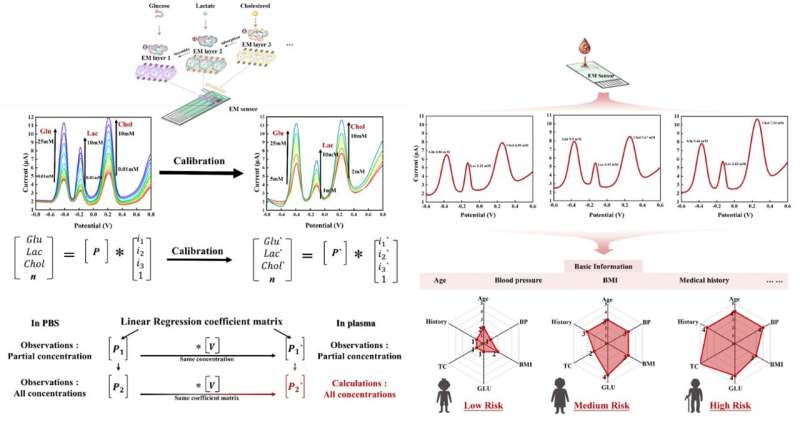This article has been reviewed according to Science X's editorial process and policies. Editors have highlighted the following attributes while ensuring the content's credibility:
fact-checked
proofread
Biosensor could be a promising candidate as a home health care tool for cardiovascular disease risk assessment

Cardiovascular diseases (CVD) are chronic diseases that cause a serious social problem, and this situation has been improved through risk assessment of CVD. Metabolic factors are the predominant risk factors for CVD.
The efficient detection of multiple metabolites will facilitate the risk assessment of CVD. Glucose (Glu), lactate (Lac), and cholesterol (Chol) are three typical metabolites that are closely related to the risk assessment of chronic CVD, reflecting the metabolic level in the body and vascular risks.
In clinical practice, different instruments and blood collection tubes are required for different metabolite detections, which are time-consuming and require professional operators. This takes up a lot of medical resources and causes a huge medical burden. The development of a sensor that detects multiple metabolites simultaneously will substantially improve the detection efficiency and reduce medical stress.
In a study published in BME Frontiers, a SIBET research team report a biosensor based on an electroenzymatic assembly transduction strategy for the simultaneous detection of three metabolites. Three EM layers were assembled on the electrode surface for a potential shift.
The electroenzymatic mediator peak separation (EMPS) method, which utilizes tunable potentials, was applied to peak separation under one test. Metabolites could be quantitatively and simultaneously detected using peak currents. The lower limit of sensitivity for detection was 0.01 mM and the detection time was less than 30 s.
In addition, the difference in detection between the phosphate-buffered saline (PBS) solution and plasma was corrected. The EM sensor was used to simultaneously detect Glu, Lac, and Chol in 242 clinical samples, and the linear correlations between the EM sensor and the laboratory results was greater than 0.980. The indicators could be readily extended by changing a suitable mediator based on the EMPS method, and the EM sensor had important practical value in clinical practice owing to good agreement and efficiency.
This research was led by Prof. Lianqun Zhou, the director of the Key Laboratory of Biomedical Laboratory at the Suzhou Institute of Medical Engineering of the Chinese Academy of Sciences.
More information: Anran Zheng et al, Efficient Simultaneous Detection of Metabolites Based on Electroenzymatic Assembly Strategy, BME Frontiers (2023). DOI: 10.34133/bmef.0027





















